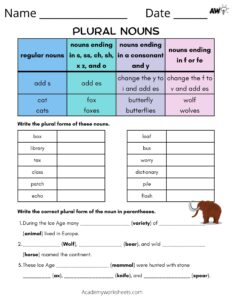What are Irregular Plural Nouns?
Irregular plural nouns are nouns in which the plural form is not formed by adding -s or -es to the singular form. Instead, they change in spelling or have a completely different word for the plural form.
Examples include “child” and “children,” “goose” and “geese,” and “man” and “men.” Knowing these forms of nouns is important for clear communication in writing and speaking.
How to Teach Irregular Plural Nouns?
Teaching these types of nouns can be a challenge, but with the right approach, it can be an engaging and effective learning experience for students. One strategy is to use visual aids such as pictures or illustrations to help students understand and remember the irregular forms of plural nouns. Another approach is to use games or activities that involve practicing irregular plurals in context. By providing multiple opportunities for students to practice and apply their knowledge, they will become more confident and proficient in using the nouns in their writing and conversation.
Remember, it’s important to understand what these nouns are. These are nouns that don’t follow the typical “-s” rule for creating plural forms. Some common examples include “children,” “mice,” and “geese.”
Now, let’s get into some strategies for teaching these nouns. One approach is to provide students with a list of the nouns and have them practice writing the plural form for each. You can also create flashcards with the singular form on one side and the plural form on the other, and have students practice matching them up.
Another key strategy is to emphasize the importance of memorization. While some irregular plural nouns do follow certain patterns, there are many that simply need to be memorized. Encourage your students to create their own mnemonics or memory aids to help them remember these tricky words.
With these tips and tricks, you’ll be well-equipped to help your students master these nouns in no time. Good luck!



